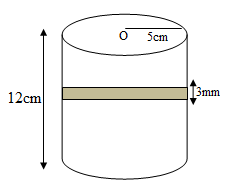
A copper wire, 3mm in diameter, is wound about a cylinder whose length is 12cm, and diameter 10 cm, so as to cover the curved surface of the cylinder. Find the length and mass of the wire, assuming the density of copper to be 8.88\[g/c{m^3}\].
Answer
572.4k+ views
Hint: In this question, first we will make the diagram indicating a turn of wire. Then we will calculate the total number of turns of wire required by dividing the height of the cylinder by the diameter of the wire. The length of the wire is equal to the multiplication of the total of turns and length for one turn. Finally, we will calculate the volume of the wire to get the mass of the wire.
Complete step-by-step solution:
The diagram is given below:

Height of cylinder = 12cm
Diameter of cylinder =10cm
Radius of cylinder= 5cm
Diameter of wire = 3mm = 0.3cm
From the diagram, we can say that 1 round of wire will cover 3mm of height.
So, the number of rounds= $\dfrac{{{\text{Height of cylinder}}}}{{{\text{Diameter of wire}}}} = \dfrac{{12cm}}{{0.3cm}}$= 40 rounds.
Total length of wire in one rotation = circumference of base of cylinder =$2\pi r = 2\pi \times 5 = 10\pi $cm
Total length of wire in 40 rounds =length in one rotation $ \times $total rotation
=$40 \times 10\pi = \dfrac{{400 \times 22}}{7}$ =1257.14cm = $\dfrac{{1257.14}}{{100}}$ =12.57m.
Now, radius of wire =$\dfrac{{Diameter}}{2} = \dfrac{{0.3}}{2}$ =0.15cm.
We know that volume = Area of cross section $ \times $ length.
So, putting the values in the above equation. we have:
Volume of wire =$\pi {r^2} \times length = \pi {\left( {0.15} \right)^2} \times 1257.14 = 88.898c{m^3}$.
Now, we know that mass = volume $ \times $density.
Therefore, mass of wire = 88.898$ \times $8.88 = 789.41gm.
Note: In this question the crucial step is a calculation of total round of wire. This is simply an application of a unitary method. So, you should have a good idea of unitary methods. The base of the cylinder is a circle, so we have used formula $2\pi r$to calculate the circumference which also gives the length of wire for one turn. Circumference of the circle is also given by the formula ‘$\pi d$’ where ‘d’ is the diameter.
Complete step-by-step solution:
The diagram is given below:

Height of cylinder = 12cm
Diameter of cylinder =10cm
Radius of cylinder= 5cm
Diameter of wire = 3mm = 0.3cm
From the diagram, we can say that 1 round of wire will cover 3mm of height.
So, the number of rounds= $\dfrac{{{\text{Height of cylinder}}}}{{{\text{Diameter of wire}}}} = \dfrac{{12cm}}{{0.3cm}}$= 40 rounds.
Total length of wire in one rotation = circumference of base of cylinder =$2\pi r = 2\pi \times 5 = 10\pi $cm
Total length of wire in 40 rounds =length in one rotation $ \times $total rotation
=$40 \times 10\pi = \dfrac{{400 \times 22}}{7}$ =1257.14cm = $\dfrac{{1257.14}}{{100}}$ =12.57m.
Now, radius of wire =$\dfrac{{Diameter}}{2} = \dfrac{{0.3}}{2}$ =0.15cm.
We know that volume = Area of cross section $ \times $ length.
So, putting the values in the above equation. we have:
Volume of wire =$\pi {r^2} \times length = \pi {\left( {0.15} \right)^2} \times 1257.14 = 88.898c{m^3}$.
Now, we know that mass = volume $ \times $density.
Therefore, mass of wire = 88.898$ \times $8.88 = 789.41gm.
Note: In this question the crucial step is a calculation of total round of wire. This is simply an application of a unitary method. So, you should have a good idea of unitary methods. The base of the cylinder is a circle, so we have used formula $2\pi r$to calculate the circumference which also gives the length of wire for one turn. Circumference of the circle is also given by the formula ‘$\pi d$’ where ‘d’ is the diameter.
Recently Updated Pages
Questions & Answers - Ask your doubts

A man running at a speed 5 ms is viewed in the side class 12 physics CBSE

State and explain Hardy Weinbergs Principle class 12 biology CBSE

Which of the following statements is wrong a Amnion class 12 biology CBSE

Two Planoconcave lenses 1 and 2 of glass of refractive class 12 physics CBSE

The compound 2 methyl 2 butene on reaction with NaIO4 class 12 chemistry CBSE

Trending doubts
Which places in India experience sunrise first and class 9 social science CBSE

Fill the blanks with the suitable prepositions 1 The class 9 english CBSE

Write the 6 fundamental rights of India and explain in detail

Difference Between Plant Cell and Animal Cell

What is the Full Form of ISI and RAW

What is pollution? How many types of pollution? Define it




